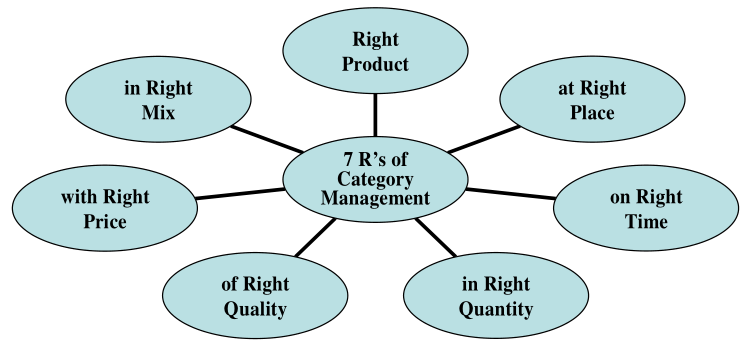Category Management is a disciplined & consistent process of managing categories as SBUs (Strategic Business Units) & producing enhanced business results by focusing on delivering value to the customers.
It is an attempt by retailers to focus their attention on product categories as opposed to individual brands. The goal is to manage a closely related line of products (category) by analyzing & accessing various factors like; sales performance, competition benchmarking, vendor insights, market research information, customer feedback, etc. to see what improvements can be made in the product mix and to identify market niches not currently being reviewed by the retailer. Rather than concentrating on what the manufacturer wants to produce or what the retailer wants sot sell, any good category management plan ought to start and stop with the customer.
Role of Category Manager ensures availability of the right Product at the right Place on the right Time in right Quantity of right Quality with right Price in right Mix. Merchandising can be termed as the analysis, planning, acquisition, handling & control of the merchandise investments of a retail operation.

Category management is responsible for the assortments of products the customer sees as reasonable substitutes for each other with similar characteristics. It also covers the process of managing merchandise with the objective of maximizing sales and profits of a category. The Category manager is also responsible for developing assortment plan for the entire category, buying process, coordinating promotions & managing vendors.
Following are the main activities which elaborate a category manager’s role.
Merchandise Planning is the evolution of a strategy at the management level to conclude what items are to be stocked. Considerations are given to consumer demand, budget limitations and the formulation of precise buying plans.
Merchandise planning is done on the basis of the mixture of categories, brands and SKUs a retail store should carry. This is done on the basis of following three parameters:
- Merchandise Variety: Variety denotes the breadth of the merchandise carried by the retailer. It is the number of merchandise categories offered by a retailer. The retailer can engage in variety strategies from a narrow variety of one or a few product lines to a wide variety encompassing a large number of product lines.
- Merchandise Assortment: Assortment is the depth of merchandise, i.e. the number of different items in a merchandise category. This refers to the number of different product items the retailer stocks within a particular product line. Assortment strategies vary from shallow assortments of one or a few SKUs within each line to deep assortments having a large selection of SKUs within each line.
- Merchandise Support: This deals with planning and controlling of the number of units the retailer should have on hand to meet expected sales for a particular SKU. Merchandise support strategies range from low (one or two units) to high (many units of a particular SKU) support levels.
Merchandise Planning is done at various levels across a Retail Chain. This flowchart is an indicator of the planning done for each retail store.
Example of Merchandise Hierarchy :

- Division: Division is the largest breakdown of merchandise in a store. Examples of divisions in a retail store can be Food & Grocery, Clothing, Furniture, Consumer Durables, etc.
- Department: It is a major grouping of merchandise that includes all types of merchandise within a division a customer can purchase. E.g. Men’s Clothing in the Clothing division, FMCG Food, Staples in Food & Grocery, Electronics, Home Appliances in Consumer Durables, etc.
- Category: This groups merchandise classifications that are complementary with each other for example; Drinks & Beverages in FMCG-Food, Skin Care, Hair Care in FMCG Non-Food, etc.
- Class: This is a group of items that are of the same type e.g. Casual clothing for young men in the Male Clothing category, Body soaps in Skin Care, Hair colors in Hair Care, etc.
- Sub-Class: An assortment of items that the customer sees as reasonable substitutes of each other. All the products in a sub-class have similar characteristics, are closely related in functionality or styling and are targeted at a specific customer segment. E.g. Sweat Shirts or Shorts in a Casual Clothing category, Antiseptic soaps in Body Soap, Fairness cream in Creams & Lotions, etc.
- Brand: A brand is a name, term, design, symbol, or any other feature that identifies one seller’s good or service as distinct from those of other sellers. E.g. Maggi, Nokia, LG, etc.
- SKU (Stock keeping unit): This is a specific product within a product line that is unique and clearly distinguishable from other products within and outside the product line & brand as well. E.g. 330ml can of Coke is one SKU & 500ml bottle of Coke is another SKU.

